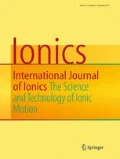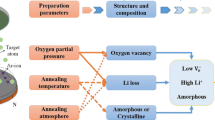Abstract
Li1.3Al0.3Ti1.7(PO4)3 (LATP) has become the focus of research because of its high ionic conductivity, high oxidation voltage, and low air sensitivity. However, Ti4+ is easily reduced by Li metal. In this paper, amorphous Li1.5Al0.5Ge1.5(PO4)3 (a-LAGP) is introduced as an interface modification layer, because LAGP has the small electrochemical potential difference and Ge4+ is more difficult to be reduced by Li. Radio frequency sputtering (RF sputtering) is adopted to modify the a-LAGP thickness less than 100 nm. Compared with crystalline LAGP layer, a-LAGP has a better effect on improving the interface stability of LATP and Li. With the a-LAGP film, the Li/a-LAGP/LATP/a-LAGP/Li symmetrical cell is still stable after 100 cycles with the over potential changing from 1 V to 3 V. The probable mechanism of the good stability between a-LAGP and Li are discussed.






Similar content being viewed by others
References
Gao Z, Sun H, Fu L, Ye F, Zhang Y, Luo W (2018) Promises, challenges, and recent progress of inorganic solid-state electrolytes for all-solid-state lithium batteries. Adv Mater 30(17):1705702
West WC, Whitacre JF, Lim JR (2004) Chemical stability enhancement of lithium conducting solid electrolyte plates using sputtered LiPON thin films. J Power Sources 126:134–138
Cheng XB, Hou TZ, Zhang R, Peng HJ, Zhao CZ, Huang JQ (2016) Dendrite-free lithium deposition induced by uniformly distributed lithium ions for efficient lithium metal batteries. Adv Mater 28:2888–2895
Zhou W, Wang S, Li Y, Xin S, Manthiram A, Goodenough JB (2016) Plating a dendrite-free lithium anode with a polymer/ceramic/polymer sandwich electrolyte. J Am Chem Soc 138:9385–9388
Manthiram A, Yu X, Wang S (2017) Lithium battery chemistries enabled by solid-state electrolytes. Nat Rev Mater 2:16103
Xu XX, Wen ZY, Yang XL, Zhang JC, Gu ZH (2006) High lithium ion conductivity glass-ceramics in Li2O–Al2O3–TiO2–P2O5 from nanoscaled glassy powders by mechanical milling. Solid State Ionics 177:2611–2615
Xu X, Wen Z, Gu Z (2004) Lithium ion conductive glass ceramics in the system Li1.4Al0.4(Ge1−xTix)1.6(PO4)3 (x=0–1.0). Solid State Ionics Diff React 171:207–213
Ma C, Chen K, Liang CD, Nan CW, Ishikawa R, More K, Chi MF (2014) Atomic-scale origin of the large grain-boundary resistance in perovskite Li-ion-conducting solid electrolytes. Energy Environ Sci 7:1638
Kasper HM (1969) Series of rare earth garnets Ln3+3M2Li+3O12 (M=Te, W). Inorg Chem 8:1000–1002
Hayashi A, Minami K, Ujiie S, Tatsumisago M (2010) Preparation and ionic conductivity of Li7P3S11−z glass-ceramic electrolytes. J Non-Cryst Solids 356:2670–2673
Lim HD, Lim HK, Xing X, Lee BS, Liu H, Coaty C (2018) Solid electrolyte layers by solution deposition. Adv Mater Interfaces 5(8):1701328
Lim HD, Yue X, Xing X, Petrova V, Gonzalez M, Liu H (2018) Designing solution chemistries for low-temperature synthesis of sulfide-based solid electrolytes. J Mater Chem A. https://doi.org/10.1039/C8TA01800F
Zhao EQ, Ma FR, Guo YD, Jin YC (2016) Stable LATP/LAGP double-layer solid electrolyte prepared via a simple dry-pressing method for solid state lithium ion batteries. RSC Adv 6:92579–92585
Zhu YZ, He XF, Mo YF (2015) Origin of outstanding stability in the lithium solid electrolyte materials: insights from thermodynamic analyses based on first-principles calculations. ACS Appl Mater Interfaces 7:23685–23693
Liu YL, Sun Q, Zhao Y, Wang BQ, Kaghazchi P, Adair KR, Li RY, Zhang C, Liu JR, Kuo LY, Hu YF, Sham TK, Zhang L, Ynag R, Lu SG, Song XP, Sun XL (2018) Stabilizing the interface of NASICON solid electrolyte against Li metal with atomic layer deposition. ACS Appl Mater Interfaces 10:31240–31248
Kotobuki M, Hoshina K, Kanamura K (2011) Electrochemical properties of thin TiO2 electrode on Li1+xAlxGe2−x(PO4)3 solid electrolyte. Solid State Ionics 198:22–25
Wolcott A, Smith WA, Kuykendall TR, Zhao YP, Zhang JZ (2099) Photoelectrochemical water splitting using dense and aligned TiO2 nanorod arrays. Small 5:104–111
Hoshina K, Yoshima K, Kotobuki M, Kanamura K (2012) Fabrication of LiNi0.5Mn1.5O4 thin film cathode by PVP sol–gel process and its application of all-solid-state lithium ion batteries using Li1+xAlxTi2−x(PO4)3 solid electrolyte. Solid State Ionics 209-210:30–35
Ling Q, Ye ZZ, Xu HR, Zhu GS, Zhang XY, Yu AB (2016) Preparation and electrical properties of amorphous Li-Al-Ti-P-O thin film electrolyte. Mater Lett 169:42–45
Chen KH, Wood KN, Kazyak E, Lepage WS, Davis AL, Sanchez AJ, Dasgupta NP (2017) Dead lithium: mass transport effects on voltage, capacity, and failure of lithium metal anodes. J Mater Chem A 5:11671–11681
Dashjav E, Ma QL, Xu Q, Tsai CL, Giarola M, Mariotto G, Tietz F (2018) The influence of water on the electrical conductivity of aluminum-substituted lithium titanium phosphates. Solid State Ionics 321:83–90
Lasri K, Dahbi M, Liivat A, Brandell D, Edstrom K, Saadoune I (2013) Intercalation and conversion reactions in Ni0.5TiOPO4 Li-ion battery anode materials. J Power Sources 229:265–271
Fu Y, Ming H, Zhao SY, Guo J, Chen MZ, Zhou Q, Zheng JW (2015) A new insight into the LiTiOPO4 as an anode material for lithium ion batteries. Electrochim Acta 185:211–217
Giarola M, Sanson A, Tietz F, Pristat S, Dashjay E, Rettenwander D, Redhammer GJ, Mariotto G (2017) Structure and vibrational dynamics of NASICON-type LiTi2(PO4)3. J Phys Chem C 121:3697–3706
Beneventi P, Bersani D, Lottici PP, Kovacs L, Cordioli F, Montenero A, Gnappi G (1995) Raman study of Bi2O3-GeO2-SiO 2 glasses. J Non-Cryst Solids 192&193:258–262
Grzechnikyz A, Chizmeshyay AVG, Wolfy GH, McMillan PF (1998) J Phys Condens Matter 10:221–233
Verweij H, Buster JHJM (1979) The structure of lithium, sodium and potassium germanate glasses, studied by Raman scattering. J Non-Cryst Solids 34:81–99
Furukawa T, White WB (1991) Raman spectroscopic investigation of the structure of silicate glasses. IV Alkali–silico–germanate glasses. J Chem Phys 95:776–784
Wang X, Zeng W, Hong L, Xu WW, Yang HK, Wang F, Duan HG, Tang M, Jiang HQ (2018) Stress-driven lithium dendrite growth mechanism and dendrite mitigation by electroplating on soft substrates. Nat Energy 3:227–235
Cheng L, Chen W, Kunz M, Persson K, Tamura N, Chen GY, Doeff M (2015) Effect of surface microstructure on electrochemical performance of garnet solid electrolytes. ACS Appl Mater Interfaces 7:2073–2081
Funding
Financial support from the National Natural Science Foundation of China (Grants 61534005, 21761132030), General Armaments Department, People’s Liberation Army of China (6140721040411), Natural Science Foundation of Jiangxi Province (20192ACBL20048), Scientific Research Project of Fujian Provincial Department of Education (JAT191150) are acknowledged.
Author information
Authors and Affiliations
Corresponding authors
Additional information
Publisher’s note
Springer Nature remains neutral with regard to jurisdictional claims in published maps and institutional affiliations.
Rights and permissions
About this article
Cite this article
Li, L., Zhang, Z., Luo, L. et al. Enhancing the interface stability of Li1.3Al0.3Ti1.7(PO4)3 and lithium metal by amorphous Li1.5Al0.5Ge1.5(PO4)3 modification. Ionics 26, 3815–3821 (2020). https://doi.org/10.1007/s11581-020-03503-x
Received:
Revised:
Accepted:
Published:
Issue Date:
DOI: https://doi.org/10.1007/s11581-020-03503-x




